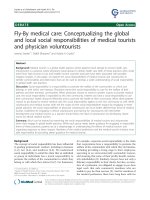Báo cáo khoa học: "Handbook of Critical Care, Revised Edition" potx
Bạn đang xem bản rút gọn của tài liệu. Xem và tải ngay bản đầy đủ của tài liệu tại đây (36.94 KB, 1 trang )
1
Available online />Written primarily for medical trainees or nurses to use during
their first exposure to critical care medicine, this 278-page
spiral bound book is a pocket-sized basic intensive care
manual. The handbook is divided into 15 chapters, eight
substantial ones covering the major organ systems, as well as
infection, nutrition, physical injury and toxicology, and brief
chapters on scoring systems and obstetrics. Many of the
sections are loaded with very clear pictures, comparative
tables, diagrams and lists, and provide more than adequate
information for juniors training in intensive care medicine. The
definitions, aetiology, clinical features and differential
diagnoses are well covered. Excellent use is made of bullet
points and numbering, which vastly increases the clarity of
presentation compared with many other books that are
pitched at a similar audience.
The chapters are written in a didactic fashion, and there is
very little discussion as to why a particular therapy or course
of treatment is recommended. Consequently, it is no surprise
that there are no references in the book to any of the major
papers that form the critical care evidence base. No
reference is made to the various national society guidelines
on, for example, the management of trauma, head injury, or
nosocomial infection. There is one reference to the Advanced
Cardiac Life Support guidelines from the American Heart
Association.
The handbook clearly has a very North American
predisposition, and given its instructive nature this could
prove confusing for trainees from Europe. Examples of the
potential conflicts include the recommendation for the
management of oliguria to ‘insert a pulmonary artery flotation
catheter, and then confirm filling with a transthoracic echo’. In
the section on asthma, the two first-line recommended drugs
are albuterol and methylprednisolone – drugs that are rarely
used for asthma in Europe. In the section on measuring
cardiac output, neither the PiCCO (Pulsion Medical Systems,
Munich, Germany) or LiDCO (LiDCO Ltd., Cambridge, UK)
device is mentioned, both of which are frequently used in
Europe. The section on infection and inflammation is weak,
which is surprising given the focus on this topic in the critical
care literature over the past 5 years.
This book has many positives, including the general clarity,
layout and the good overviews of most of the subjects
covered. However, I suspect that for some European trainees
the advantages would be outweighed by the frustrations that
may result from the differences in specific treatment
protocols used between North America and Europe.
Competing interests
The author(s) declare that they have no competing interests.
Book report
Handbook of Critical Care, Revised Edition
Duncan Wyncoll
Consultant Intensivist, Guy’s & St Thomas’ NHS Foundation Trust, London, UK
Corresponding author: Duncan Wyncoll,
Published online: 26 October 2005
Critical Care 2005, 9:E27 (DOI 10.1186/cc3889)
This article is online at />© 2005 BioMed Central Ltd
Hall JB, Murphy P: Handbook of Critical Care, revised edition. London, UK: Science Press; 2003. 278 pp. Paperback.
ISBN 1858739861









